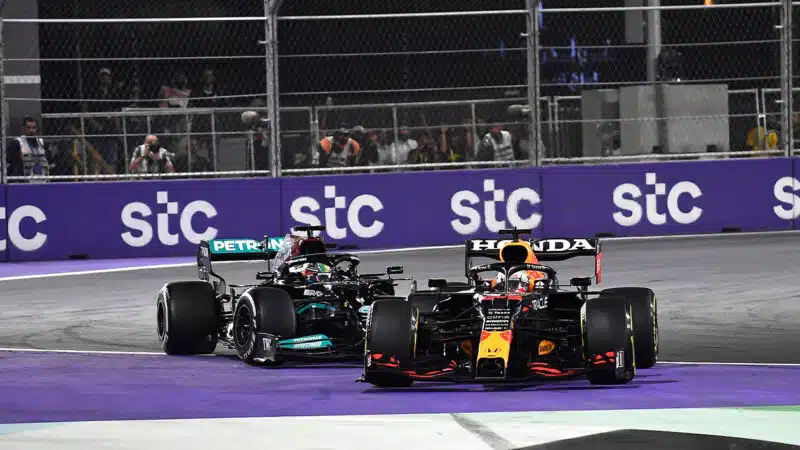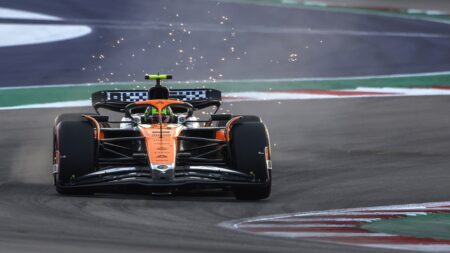Last Sunday Max Verstappen ran Lando Norris off the road at Turn 12 of the Circuit of the Americas as the McLaren driver attempted an overtake. Norris did get past – but was a long way off the circuit as he did so and so was penalised 5sec, giving the place officially to Verstappen. But Verstappen was also off the track as Norris passed him. This was a less extreme example of the tactic Verstappen had used to prevent Lewis Hamilton passing him at Turn 4 Interlagos, 2021 (and Turn 1 Jeddah, also ’21).
According to the regulations and the stewards’ guidelines, the ’21 incidents were legal moves. They met the letter. And that’s what Verstappen plays with. In extremis, he games the regulations regarding such matters. It’s part of his complete, no-weakness armour. In response to those moves the FIA issued further guidelines specifying you must stay on track for the move to count.
You can force the other guy off, knowing what would have been an overtake will not now count
But in attempting to fit all of racing’s infinite number of wheel-to-wheel situations into a box, it’s at the disconnect – between what the rules are trying to achieve and what they inadvertently make possible – that things get complicated. Especially when you have ruthless winning machines like Verstappen around to exploit the possibilities in the gaps between the words. See also Michael Schumacher in a previous era.
We can look at what happened at Turn 12 on Sunday and Turn 4 Brazil ’21 as two examples of the same situation, but with different guidelines in place. Essentially, because Verstappen, on the inside in both cases, was the car ahead at the apex, it was his corner in Brazil. Because it’s his corner he can choose whatever line he likes and it’s up to the other guy to get out the way. That’s why he was essentially legal to the letter of the regulation in Brazil. But the guidelines now insist the defending driver on the inside stay within track limits – which in Austin, he again did not.
The stewards argue that part of Norris’s 5sec penalty incorporated also Verstappen’s offence – i.e. it would have been more than a 5sec penalty but they reduced it to a net 5sec.
However, insisting on also penalising the driver who has been forced off, insisting he cannot complete the overtake, still allows the regulation to be gamed by the driver in the Verstappen situation. It still means you can force the other guy off, in the knowledge that what would otherwise have been an overtake but for your foul will not now count.
It still opens the way for the driver ahead on the inside to not even attempt to make the corner without going off the track on exit. To go so fast to ensure he is ahead at the apex, that there’s no way he can stay within track limits on the exit. Austin on Sunday was slightly different from Brazil ’21 in that although Verstappen was ahead at the apex, he didn’t run off the track because he was going too fast to stay on it – he ran off the track because that’s where he steered the car. As McLaren’s Andrea Stella said, “The defending car [Verstappen] goes just straight at the apex. We checked the video multiple times. It is just going straight. It is just going off the track as much as Lando is doing, just giving no chance for Lando to complete the manoeuvre.” He’s making no attempt to continue to turn once he’s made the apex. In Brazil he was going so fast there’s no way he could have stayed on track. This time it was subtly different. But the point remains: he was ahead at the apex, therefore he was able to nullify a legitimate overtake of him. Even if there was an element of Verstappen censure in the small penalty Norris got, that was a way better outcome for him than if he had accepted the legitimate overtake.
If we must have rules in writing regarding on-track etiquette and if we must have track limits defined by white lines rather than something physical, then that rule needs to be changed. If the only way the defending driver on the inside can defend is by running himself (and the other driver on the outside) off the track, then the defence should be invalid. Therefore the driver forced off the track should be allowed to complete the passing manoeuvre without penalty regardless of being off track when they did so.
Sounds simple enough, doesn’t it? But hang on. That would then open the way for the driver on the outside to game the rules. They could ensure they were ahead at the apex by going so fast that there’s no way they could stay on track on the exit, and could thereby complete the overtake off track.
So the rule should also state that a passing attempt around the outside, where the outside driver is ahead at the apex, will only be valid if that outside driver can stay on track.



